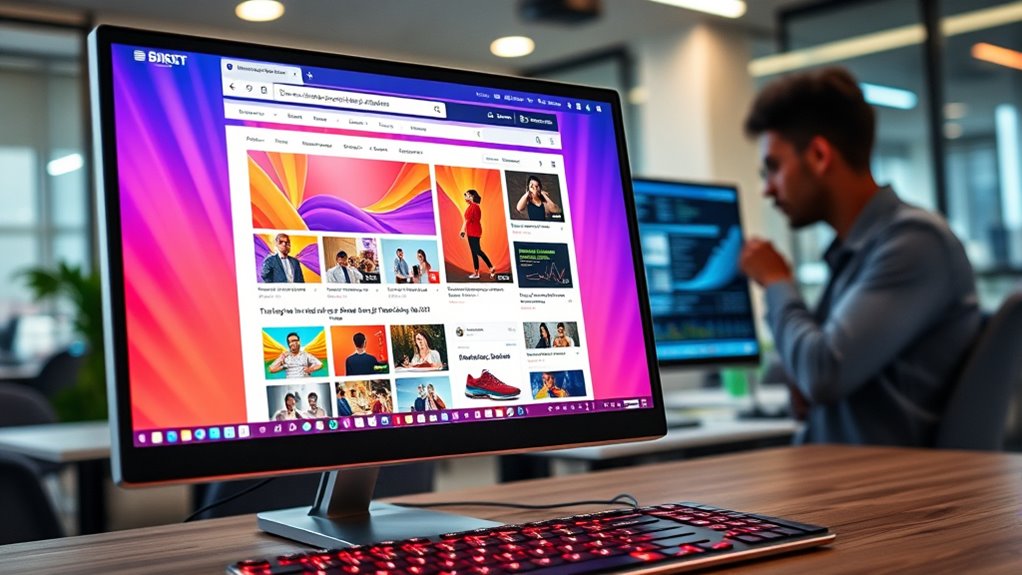AI-powered personalization helps you create websites that respond to your visitors in real time, tailoring content based on their preferences, behaviors, and data. It instantly adapts banners, product suggestions, and recommendations to keep users engaged and satisfied. By segmenting visitors and analyzing their interactions, you can deliver more relevant experiences that build trust and boost conversions. To uncover how this technology can transform your site, explore the details that follow.
Key Takeaways
- Implement real-time AI personalization to deliver tailored content that responds instantly to user preferences and behaviors.
- Use AI algorithms for user segmentation, enabling targeted messaging and recommendations based on browsing, purchase, and location data.
- Dynamically adjust website elements like banners and product suggestions based on visitor interactions for enhanced engagement.
- Ensure personalized content remains accurate and trustworthy to build user confidence and improve satisfaction.
- Continuously analyze user data to refine recommendations, increasing relevance, loyalty, and conversion rates over time.

AI-powered personalization is transforming the way businesses engage with their customers by delivering tailored experiences in real time. When you implement AI-driven tools, you can create dynamic content that adapts instantly to each visitor’s preferences, behaviors, and needs. This means your website no longer offers a one-size-fits-all experience; instead, it becomes a responsive environment that changes based on who’s visiting. By leveraging AI, you can serve highly relevant content to your users, increasing engagement and converting visitors into loyal customers.
AI personalization tailors website experiences in real time, boosting engagement and turning visitors into loyal customers.
A key component of this personalization is user segmentation. Instead of treating all visitors the same, AI algorithms analyze data points such as browsing history, purchase patterns, geographic location, and device type to categorize users into specific segments. This segmentation allows you to tailor your messaging, recommendations, and calls to action for each group. For example, new visitors might see introductory offers, while returning customers are presented with loyalty rewards or related products. User segmentation enables you to deliver more meaningful experiences, making your website feel intuitive and personalized rather than generic.
Dynamic content is another indispensable element in AI-powered personalization. It involves real-time updates to your website’s elements—such as banners, product listings, or blog suggestions—based on the visitor’s profile. As a user navigates your site, AI continuously analyzes their interactions and adjusts the displayed content accordingly. If someone looks at several outdoor gear items, your site can dynamically highlight related products or outdoor activity tips. This immediate responsiveness keeps visitors engaged and guides them toward actions that benefit both them and your business.
Additionally, understanding the importance of content accuracy ensures that the personalized content remains trustworthy and relevant, further enhancing user trust and satisfaction. You don’t need to be a tech expert to harness these capabilities. Many AI personalization tools integrate seamlessly with your existing website platform, offering user-friendly interfaces for setting up dynamic content rules and segmentation criteria. Once configured, these systems work behind the scenes, learning from user interactions and refining their recommendations over time. The more visitors you attract, the smarter your personalization becomes, resulting in a continuously improving customer experience.
In essence, AI-powered personalization empowers you to craft a website that feels uniquely tailored to each visitor. By utilizing user segmentation and dynamic content, you can increase relevance, foster loyalty, and ultimately drive more conversions. The ability to deliver timely, personalized experiences in real time isn’t just a competitive advantage anymore; it’s a necessity in today’s digital landscape. With AI, you gain the tools to make your website more engaging, responsive, and aligned with your customers’ expectations.
Frequently Asked Questions
How Does AI Personalization Improve User Engagement?
Imagine your website becomes a friendly guide, reading your visitors’ minds. By tracking their behavior, you can tailor content customization to match their interests perfectly. This dynamic interaction keeps users engaged, making them feel understood and valued. As a result, they’re more likely to stay longer, explore more, and return often. AI personalization transforms your site into a personalized experience, turning casual visitors into loyal fans.
What Privacy Concerns Are Associated With Ai-Driven Personalization?
You should be aware that AI-driven personalization raises privacy concerns, especially around data privacy and user tracking. As you collect user data to tailor experiences, you risk exposing sensitive information or violating privacy laws. It is crucial to be transparent about data collection practices, obtain user consent, and implement robust security measures. This way, you protect users’ privacy while still delivering personalized content effectively.
Can Small Businesses Implement AI Personalization Cost-Effectively?
Yes, small businesses can implement AI personalization cost-effectively by focusing on scalable strategies. Start with affordable tools like chatbots or recommendation engines that grow with your needs. Prioritize features that deliver the most value, and use cloud-based solutions to reduce infrastructure costs. This approach allows you to experiment and expand gradually, making AI-driven personalization accessible without overspending.
How Does AI Adapt to Changing User Preferences Over Time?
AI adapts to changing user preferences over time by continuously updating user profiles through dynamic content and interactions. It analyzes behaviors and feedback, then adjusts website elements to match evolving interests. This ongoing process guarantees your site remains relevant and engaging, providing personalized experiences that reflect current user needs. By leveraging AI-driven insights, you create a more responsive, tailored environment that keeps visitors engaged and encourages repeat visits.
What Are the Best Tools for Integrating AI Personalization Into Websites?
You should consider tools like Adobe Target, Dynamic Yield, or Optimizely, which seamlessly integrate AI personalization into your website. These platforms leverage machine learning and data analysis to tailor content based on user behavior, preferences, and real-time interactions. They allow you to create personalized experiences that adapt as users engage, boosting engagement and conversions. With these tools, you can efficiently enhance your website’s personalization strategy and deliver a more relevant user experience.
Conclusion
By harnessing AI-powered personalization, you can create websites that truly adapt to each user’s needs. Imagine a clothing retailer that uses AI to recommend outfits based on browsing habits, boosting sales and customer satisfaction. As you implement these smart features, you’ll deliver more relevant content, foster loyalty, and stand out in a crowded digital landscape. Embrace AI-driven personalization, and watch your website become a dynamic, engaging experience tailored just for every visitor.









